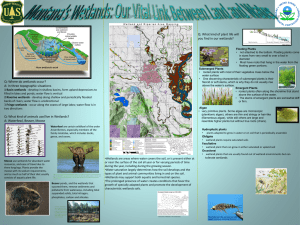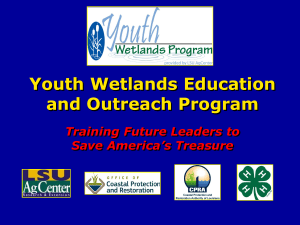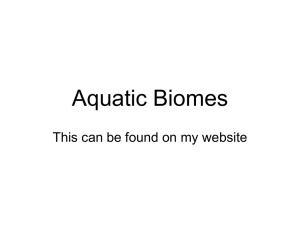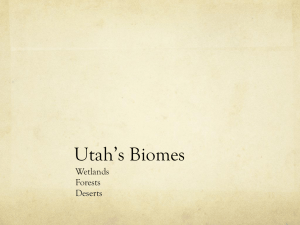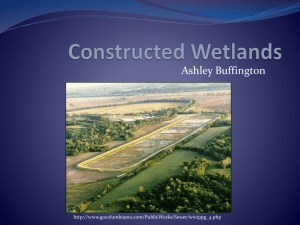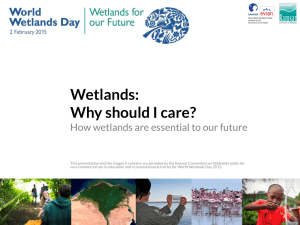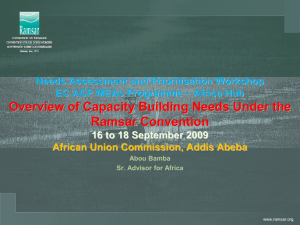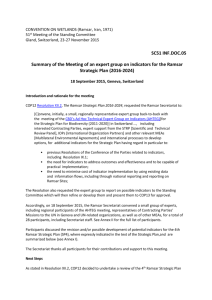Wetlands and biofuels 2
advertisement
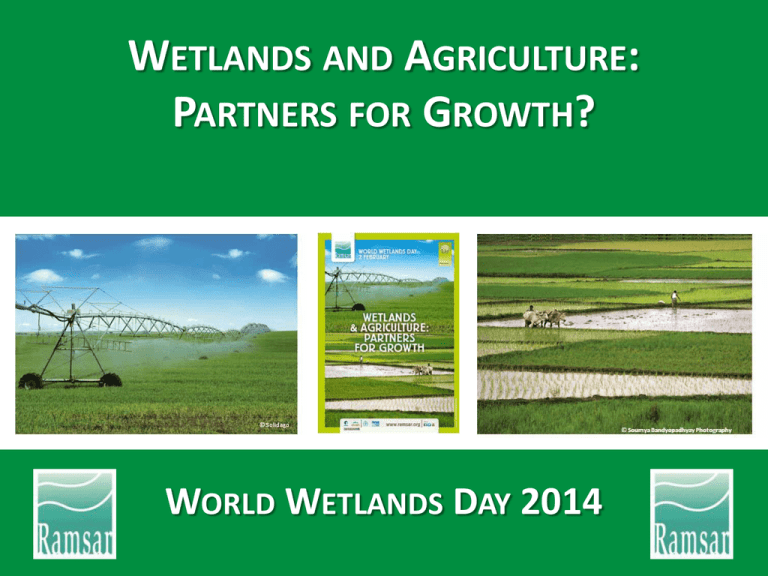
WETLANDS AND AGRICULTURE: PARTNERS FOR GROWTH? WORLD WETLANDS DAY 2014 Wetlands & Agriculture: Partners for Growth? WWD 2014 Our World Wetlands Day (WWD) leaflet for 2014 looks at the relationship between agriculture and wetlands, at the role wetlands play in agriculture, at the negative impacts agriculture can have on wetlands, and at some of the creative solutions that are in use to reduce these impacts. It illustrates the need for real PARTNERSHIP between the two sectors (and with the water sector) to look at positive solutions and reduce the negative impacts. Read the leaflet here in flashbook or download it in PDF www.ramsar.org/wwwd2014 This Powerpoint presentation is based on the leaflet. We hope that you will adapt and customize it to tell YOUR story about Wetlands and agriculture for your WWD event. ABOUT THE IMAGES IN THIS PPT PLEASE NOTE • The photographs in this PPT are copyrighted • They can be used in any adaptations of this PPT that you may prepare for a World Wetlands Day event • They may not be used for any other purpose without prior permission of the individual photographers. Contact the Secretariat on ramsar@ramsar.org for further information • Please do substitute other more relevant images for your own situation THANK YOU FOR YOUR COOPERATION CONTENTS DEFINING WETLANDS, DEFINING AGRICULTURE, AND THE SCALE OF AGRICULTURE WETLANDS USED FOR AGRICULTURE...COMPLEX INTERACTIONS IMPACT OF AGRICULTURE & SOME FACTS AND FIGURES ABOUT WATER USE AGRICULTURAL VS NATURAL ECOSYSTEM SERVICES AGRICULTURE IN RAMSAR SITES DEFINING WETLANDS, DEFINING AGRICULTURE, & THE SCALE OF AGRICULTURE... Defining agriculture ....... “the deliberate effort to modify a portion of Earth's surface through the cultivation of crops and the raising of livestock for sustenance or economic gain”. Crops can provide food, fuel, medicines. For our purposes, this definition of agriculture includes land-based agriculture, inland and coastal aquaculture. Aquaculture as defined by FAO includes the farming of animals (e.g. crustaceans, finfish and molluscs) and plants (e.g. seaweeds and freshwater macrophytes). Defining wetlands ....... Ramsar uses a broad definition of wetlands, including lakes and rivers, swamps and marshes, wet grasslands and peatlands, oases, estuaries, deltas and tidal flats, near-shore marine areas, mangroves and coral reefs, and human-made sites such as fish ponds, rice paddies, reservoirs, and salt pans. SCALES AND TYPES OF AGRICULTURE Uses more fertilizers, chemicals, modern machinery or manual labour; generates higher levels of productivity from relatively smaller areas Uses smaller inputs relative to land area – relies more on natural processes and productivity Crop production can be or Irrigation through spraying or mist-jet, and drip irrigation systems Bring together crop farming, animal husbandry, sometimes aquaculture in one farming system. Can be intensive or extensive. WETLANDS USED FOR AGRICULTURE... COMPLEX INTERACTIONS COMPLEX INTERACTIONS ...... WETLANDS USED FOR AGRICULTURE MAY BE: • Wetlands dependent on continued agricultural activities to maintain ecological character - such as mowing and grazing in wet grasslands. • Wetlands that have been converted to support agriculture, e.g., flood recession agriculture in floodplains; rice paddies, coastal grazing marshes. • Wetlands maintained in a natural state for production and harvesting of specific products, e.g., wild rice beds in a wetland that are managed and harvested using traditional techniques. • Wetland systems constructed or managed expressly for agriculture may also have significant wetland biodiversity values e.g., cranberry bogs, fish ponds, or reservoirs originally built for irrigation which also support migratory waterbirds and other wetland species. A coastal grazing marsh in the Axios Delta, Greece. Grazing helps maintain the marsh ecosystem. WETLANDS AND BIOFUELS 1 – FRIENDS? FOES? Cultivation of crops for bioenergy has increased rapidly since 2000; land requirements by 2030 are expected to be about 35 million hectares. Land and water impacts on wetlands from biofuel production can be significant... Tropical peatlands in southeast Asia have been drained for production of palm oil for bioenergy (approx 880,000 ha by early 2000s) Sugar cane in many parts of Africa is planted in or near wetlands , some for biofuel production – this causes wetland loss, heavy water use, and affects soil fertility M.J. Silvius WETLANDS AND BIOFUELS 2 – FRIENDS? FOES? Cultivation of crops for bioenergy has increased rapidly since 2000; land requirements by 2030 are expected to be about 35 million hectares. Land and water impacts on wetlands from biofuel production can be significant... In the Neotropics oil palm plantations adjacent to wetlands have caused the loss of natural vegetation and water pollution. KEY MESSAGE 1 Wetlands serve as valuable natural infrastructure for agriculture, providing reliable water and fertile soils, but they are at risk from agriculture’s growing demands for land and water. They are increasingly threatened by population growth, large-scale development initiatives intended to alleviate poverty, and the possible impacts of climate change. The functions and economic values of wetlands must be considered in planning for the production of food and other agricultural products. IMPACT OF AGRICULTURE; WATER FACTS AND FIGURES IMPACTS OF AGRICULTURE ON WETLANDS - IN BRIEF Water quantity impacts that damage/alter wetlands: • Decreases in flows due to dams and water abstraction (surface and groundwater) for irrigation or other purposes • Increases in river flows or water levels due to irrigation return flows or dam releases • Changes in the timing/patterns of river flows Water quality impacts: Intensive agriculture activities including intensive aquaculture often lead to increased loads of pollutants such as pesticides, fertilizers, antibiotics and disinfectants affecting wetland and human health & drinking water quality Wetland conversion and disturbance impacts through agriculture: • Introduction of invasive species • Introduction of human and animal disease vectors • Disturbance of breeding, migration, feeding patterns of wetland fauna Percentage of all withdrawals from surface water and groundwater used for agricultural purposes. Most is used for irrigation: some finds its way back to rivers and groundwater as return flows, the rest returns to the atmosphere through evapotranspiration. The approximate percentage of irrigated areas that rely on groundwater either as a primary source or in conjunction with other sources of water. Estimated percentage of current agricultural water needs met by irrigation – the rest is provided by rainfall. Balance between rainfed and irrigated agriculture is highly variable around the world (see Fig 2) WATER USE IN RAINFED AND IRRIGATED AGRICULTURE Rainfed agriculture relies largely upon GREEN WATER. Irrigated agriculture relies mostly on wetlands - BLUE WATER. 20% of our current agricultural water needs are met by IRRIGATION; 80% from RAINFALL. Source: www.iwmi.cgiar.org/Assessment/ Fig. 1 Estimated increase by 2050 of current agricultural water consumption mostly for irrigated agriculture in already water scarce areas. % of World’s land surface used for crop production. Crop area is not increasing fast but intensification is. Irrigated areas have doubled in the last 50 years. Average growth per year in food fish production from aquaculture from 1970 to 2008 – brings more pressure on inland and coastal wetlands. BALANCE BETWEEN RAINFED AND IRRIGATED AGRICULTURE IS HIGHLY VARIABLE AROUND THE WORLD Source: www.iwmi.cgiar.org/Assessment/ Pie charts show total crop water evapotranspiration in km3 by region. The map shows those areas heavily dependent on irrigated water for agriculture. Estimated that 20% of agricultural water comes blue water (= wetlands & groundwater); 80% from green water. Fig. 2 KEY MESSAGE 2 In many parts of the world water resources have already been utilized at or beyond their sustainable limits. Agriculture will need more water to support more people in future, yet wetlands must still have enough water to maintain their ecological character and essential ecosystem services. KEY MESSAGE 3 Agriculture will need more land to support more people in the future, but conversion of wetlands for agriculture will lead to the loss of vital wetland ecosystem services. AGRICULTURAL VS NATURAL ECOSYSTEM SERVICES NATURE’S CAPITAL WETLAND ECOSYSTEM SERVICES Provisioning services: production of food, fuelwood, fish, water storage etc. Regulating services : climate regulation, water purification etc. Cultural services : recreation, spiritual value, educational value etc. VALUE OF WETLAND ECOSYSTEM SERVICES: www.ramsar.org/TEEB-report From: Agricultural Water Management 97(4): 512-519 AGRICULTURAL VS NATURAL ECOSYSTEM SERVICES Agriculture tends to result in more emphasis on provisioning services. This often results in the reduction of naturally occurring regulating services – such as pollination, water balance regulation, and pest control . ya Bandyopadhyay Photography REDUCING AGRICULTURAL IMPACTS © Solidago REDUCING THE IMPACTS OF AGRICULTURE ON WETLANDS MORE CROP PER DROP INTEGRATED WATER RESOURCES PLANNING REDUCING THE IMPACTS OF AGRICULTURE ON WATER QUALITY MORE CROP PER DROP e.g. through improved efficiency in irrigation technologies use of drought-tolerant crop varieties to reduce irrigation needs cultivation of more flood-tolerant crops use of smart phone technologies to give farmers access to weather and crop data in the field water re-use and wastewater use in agriculture to reduce water withdrawals return flows from urban areas to reduce withdrawals (and wetlands can help provide treatment) INTEGRATED WATER RESOURCES PLANNING e.g. large dams may reduce vulnerability of farmers to drought small local storage options – such as tanks and farm dams - can provide local resilience and sustain wetland biodiversity large dams can be designed and operated for multiple uses such as agriculture, hydropower, fisheries and recreation, and should allow water releases for downstream ecosystems REDUCING THE IMPACTS OF AGRICULTURE ON WATER QUALITY e.g. Using options such as conservation tillage and organic farming can reduce pollution loads reaching wetlands Integrated pest management can reduce pesticide needs Combined production systems can utilize livestock manure to fertilize crops and aquaculture (and reduce costs at the same time) AGRICULTURE IN RAMSAR SITES AGRICULTURE IN RAMSAR SITES – DID YOU KNOW? 20% of Ramsar Sites (August 2013) include one or more of these Ramsar wetland types: Aquaculture Ponds, i.e., farm or stock ponds, small tanks Irrigated land including irrigation channels, rice fields Seasonally flooded irrigation land A complex of streams, marshes and lakes where a local conservation network has joined efforts with the users of water from the wetland for agriculture. New crops have been introduced such as the prickly pear from which the vegetable nopal is prepared. This cactus has replaced traditional crops with higher water requirements, generating higher income for farmers and reducing the water needs from the wetland. A© PFF Cuatrociénagas MEXICO: CUATRO CIÉNEGAS WILDILFE PROTECTION AREA RAMSAR SITE IRAQ: HAWIZEH MARSH (HAUR AL-HAWIZEH) RAMSAR SITE Jassim Al-Asadi The indigenous tribes of Marsh Arabs, or Madans, have practiced their traditional agriculture in the Mesopotamian Marshlands for over 5,000 years, gathering reeds, cultivating cereals and date palm, grazing large livestock, fishing and hunting. Jassim Al-Asadi Jassim Al-Asadi ALGERIA: OASIS DE OULED SAÏD RAMSAR SITE This human-made Ramsar Site was created on the remains of a “fossil” wadi where a traditional “fouggara” system has been constructed for the capture and distribution of groundwater. The water, distributed in small openair channels is shared out equitably to individual gardens for the cultivation of palms, cereals and fruits. The site is also important for migratory birds and includes important archaeological remains of “Ksars” (fortresses) from the 14th century. The marshes of the Cotentin and Bessin in France are flooded in winter and provide a huge area for fish and waterbirds. When they dry in spring, local farmers release their cattle on the rich pasture land. The surrounding higher meadows are used for hay making. This sustainable way of dairy farming evolved in Medieval times and still suits modern agricultural needs. Ikmo-ned on wikimedia under CC-by-SA license FRANCE: COTENTIN & BESSIN MARSHES RAMSAR SITE © Ikmo-ned on wikimedia under CC-by-SA license JAPAN: KABUKURI-NUMA RAMSAR SITE These rice paddies are farmed organically AND are managed to attract wintering waterbirds. In winter and post-harvest, the rice fields are left flooded for wild birds to winter in the site; later the nutrient-rich soil from droppings is used as natural fertilizer for the wild rice, in addition to controlling weeds and pests. Good for farmers, birds and birdwatchers! KEY MESSAGE 4 Improving the agricultural productivity of land and water can help to limit the amount of water that is withdrawn from wetlands and discourage their conversion for agriculture. KEY MESSAGE 5 Intensification of agricultural activities can provide some efficiency gains, and so too can adoption of new technologies by farmers or the reintroduction of traditional practices with new technological support. KEY MESSAGE 6 Managing land and water to create multifunctional agroecosystems helps to provide diversity and resilience for livelihoods and maintain a balance between provisioning, regulating, supporting, and cultural wetland ecosystem services. And finally ... Please use our cartoon as a teaching aid to tell a story. Or use the blank cartoon to create your own story www.ramsar.org/wwd2014 © Gary Shackelford www.ramsar.org Ramsar’s WWD materials are generously supported by the Danone Fund for Water The leaflet was produced in collaboration with the UN Food and Agriculture Organization and the International Water Management Institute

